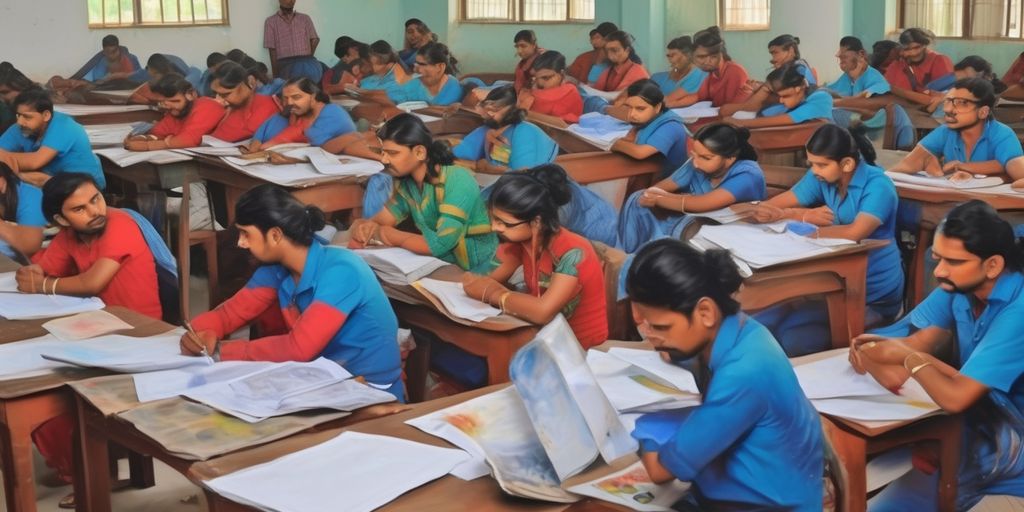The CUET (UG) 2024 results are just around the corner, and students across the country are eagerly waiting for the big announcement. This guide will provide you with all the essential information you need to know about the CUET (UG) 2024 results, from understanding the exam itself to the steps you need to take after receiving your scorecard. Whether you’re wondering about the key dates, how to check your results, or what to do next, we’ve got you covered.
Key Takeaways
- The CUET (UG) 2024 results are expected to be released by the end of July 2024.
- Students can check their results online using the official CUET website.
- The scorecard will include both sectional and total scores, along with other important details.
- If there are any discrepancies in the scorecard, students should report them immediately.
- Post-result procedures include checking cut-off marks, participating in counseling, and preparing necessary documents for admission.
Understanding the CUET (UG) 2024 Examination
The Common University Entrance Test (CUET) for undergraduates is a crucial exam for students completing their class 12. It opens doors to various universities, offering a wide range of courses. This exam is essential for those aiming to personalize their academic journey and gain a competitive edge in university admissions. Preparing effectively is key to success in this exam.
The CUET (UG) 2024 will be conducted in multiple shifts to accommodate all candidates. The exam dates and schedule will be announced on the official website. It’s important to keep track of these dates to ensure you don’t miss any deadlines. The exam will be held in both offline and computer-based test (CBT) modes, depending on the subject.
To be eligible for the CUET (UG) 2024, candidates must have completed their class 12 or equivalent examination. There are no age restrictions for this exam. However, each participating university may have its own specific eligibility criteria, so it’s advisable to check the requirements of the universities you are interested in.
The CUET (UG) 2024 is a vital step for students aiming to unlock university doors. It offers diverse university choices and a chance to embark on a personalized academic journey.
How to Access Your CUET (UG) 2024 Results
Step-by-Step Guide to Checking Results Online
To check your CUET (UG) 2024 results, follow these simple steps:
- Visit the official website: exams.nta.ac.in/CUET-UG/.
- On the homepage, click the link that reads ‘CUET UG 2024 results’.
- A new page will appear on the screen.
- Enter your application number and date of birth.
- Click on the submit button.
- Your CUET UG 2024 Results will appear on the screen.
- Download and print your result for future reference.
Important Websites and Links
Here are some key websites and links to keep in mind:
Common Issues and Troubleshooting
If you face any issues while checking your results, consider these common problems and solutions:
- Incorrect Login Credentials: Double-check your application number and date of birth.
- Website Downtime: If the site is down, wait a few minutes and try again.
- Browser Issues: Clear your browser cache or try a different browser.
If problems persist, contact the NTA helpline for assistance.
By following these steps and tips, you can easily access your CUET (UG) 2024 results without any hassle.
Interpreting Your CUET (UG) 2024 Scorecard
Details Mentioned on the Scorecard
Your CUET 2024 scorecard will have several important details. These include your name, roll number, date of birth, and photograph. It will also show your category (General, OBC, SC, etc.), total marks scored, and marks obtained in each section. Additionally, your signature will be present on the scorecard.
Understanding Sectional and Total Scores
The CUET scorecard provides both sectional and total scores. Each section of the exam is scored separately, and these scores are then combined to give a total score. The scores range from 120 to 135 at their lowest. Understanding these scores is crucial for knowing where you stand in the merit list.
What to Do If You Find Discrepancies
If you find any discrepancies in your scorecard, it is important to act quickly. The CUET authorities do not allow for re-evaluation or rechecking of the results. Therefore, you should immediately contact the official helpdesk through the website cuet.samarth.ac.in to report any issues.
Always double-check your scorecard for any errors. Quick action can help resolve issues faster.
Post-Result Procedures for CUET (UG) 2024
Cut-off Marks and Merit Lists
After the CUET (UG) 2024 results are announced, each participating university will release its own cut-off marks. These cut-off marks are the minimum scores required for admission to various programs. Merit lists will be prepared based on these cut-off marks and the candidates’ scores. It’s important to regularly check the official websites of the universities you have applied to for updates on cut-off marks and merit lists.
Counseling and Admission Process
The counseling process will begin soon after the merit lists are published. Candidates who meet the cut-off criteria will be invited for counseling sessions. During these sessions, you will have to choose your preferred courses and universities. The counseling process usually involves several rounds, so make sure to stay updated with the schedule. Here are the general steps involved:
- Registration: Sign up for the counseling process on the official website.
- Choice Filling: Select your preferred courses and universities.
- Seat Allotment: Seats will be allotted based on your rank and preferences.
- Document Verification: Verify your documents at the designated centers.
- Admission Confirmation: Pay the admission fee to confirm your seat.
Important Documents for Admission
When you go for the counseling and admission process, you will need to bring several important documents. These documents are crucial for verifying your eligibility and securing your admission. Here is a list of the essential documents you should have:
- CUET (UG) 2024 Scorecard
- Admit Card
- Class 10th and 12th Mark Sheets
- Transfer Certificate (TC)
- Migration Certificate
- Category Certificate (if applicable)
- Passport-sized Photographs
- Any other documents specified by the university
Make sure all your documents are in order and keep multiple copies for safety. Missing documents can delay or even cancel your admission process.
Special Notices and Announcements
Retest for Affected Candidates
If you faced any issues during the CUET (UG) 2024 exam, you might be eligible for a retest. The authorities have announced that a retest will be conducted for candidates who were affected by technical glitches or other disruptions. Make sure to check the official website for updates and instructions on how to apply for the retest.
Provisional Answer Keys and Challenges
After the exam, provisional answer keys will be released. You can review these keys and challenge any answers you believe are incorrect. This is a crucial step to ensure the accuracy of your results. Keep an eye on the announcement dates and follow the guidelines for submitting challenges.
Advisories for Specific Exam Centers
Special advisories have been issued for certain exam centers. If your exam center is among those listed, please read the advisories carefully. These notices may include important information about entry procedures, required documents, and other specific instructions to ensure a smooth examination process.
Stay updated with the latest announcements to avoid missing any critical information regarding the CUET (UG) 2024. Regularly visit the official website and keep an eye on your registered email for notifications.
Preparation Tips for Future CUET Aspirants
Recommended Study Materials
Choosing the right study materials is crucial for your CUET preparation. Revise CUET past years’ test questions at least twice to get a sense of the exam format and question difficulty level. Additionally, spend extra time doing mock tests, sample papers, and model question papers. Consider the reputation, teachers, and success rate when selecting a coaching center. Online coaching can also be effective, and some centers offer scholarships.
Time Management Strategies
Effective time management can make a significant difference in your preparation. Create a study schedule that allocates time for each subject and stick to it. Use online resources to find tips on time management and success stories from previous aspirants. Remember, consistency is key.
Common Mistakes to Avoid
Avoiding common mistakes can save you a lot of time and stress. Here are some pitfalls to watch out for:
- Not following a study schedule
- Ignoring weaker subjects
- Relying solely on one type of study material
- Not taking enough mock tests
Pro Tip: Always review your answers and understand your mistakes to improve continuously.
By following these tips, you’ll be better prepared to tackle the CUET and achieve your desired score.
Getting ready for the CUET can be a big task, but with the right tips, you can do it! Start by understanding the exam pattern and choosing the right subjects. Practice regularly and take mock tests to see how you’re doing. For more detailed tips and resources, visit our website and get all the help you need to succeed.
Conclusion
The CUET Results 2024 are just around the corner, and it’s important for all candidates to stay updated with the latest announcements. Make sure to keep an eye on the official website for any new information. Remember, this is a significant step in your academic journey, so prepare accordingly and stay positive. Good luck to all the students awaiting their results!
Frequently Asked Questions
When will the CUET (UG) 2024 results be announced?
The results for CUET (UG) 2024 are expected to be released by the end of July 2024. Keep an eye on the official website for the exact date.
How can I check my CUET (UG) 2024 results online?
To check your results, visit the official CUET website and log in using your registration details. Follow the prompts to view and download your scorecard.
What should I do if I find an error in my CUET (UG) 2024 scorecard?
If you find any discrepancies in your scorecard, contact the examination authorities immediately through the provided helpline numbers or email.
What documents are needed for the CUET (UG) 2024 counseling process?
You will need your CUET scorecard, admit card, ID proof, passport-sized photos, and other academic certificates for the counseling process.
Is there a retest option for CUET (UG) 2024 if I missed the exam?
A retest is usually conducted only for candidates who were affected by specific issues like technical problems. Check official notices for more details.
Where can I find the provisional answer keys for CUET (UG) 2024?
The provisional answer keys will be available on the official CUET website. You can download them and raise challenges if you find any errors.









